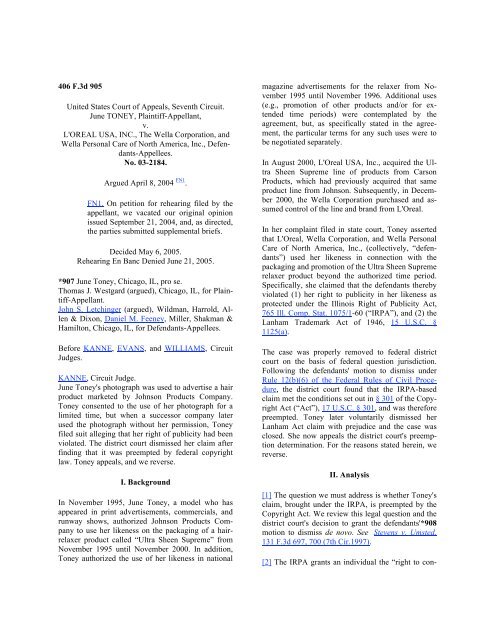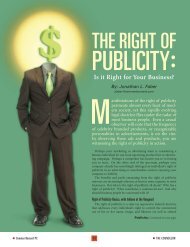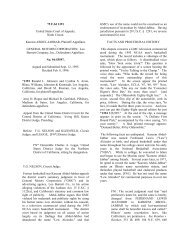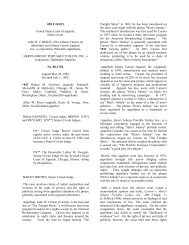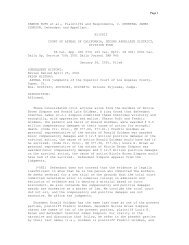Toney v. L'Oreal - Right Of Publicity
Toney v. L'Oreal - Right Of Publicity
Toney v. L'Oreal - Right Of Publicity
Create successful ePaper yourself
Turn your PDF publications into a flip-book with our unique Google optimized e-Paper software.
406 F.3d 905<br />
United States Court of Appeals, Seventh Circuit.<br />
June TONEY, Plaintiff-Appellant,<br />
v.<br />
L'OREAL USA, INC., The Wella Corporation, and<br />
Wella Personal Care of North America, Inc., Defendants-Appellees.<br />
No. 03-2184.<br />
Argued April 8, 2004 FN1 .<br />
FN1. On petition for rehearing filed by the<br />
appellant, we vacated our original opinion<br />
issued September 21, 2004, and, as directed,<br />
the parties submitted supplemental briefs.<br />
Decided May 6, 2005.<br />
Rehearing En Banc Denied June 21, 2005.<br />
*907 June <strong>Toney</strong>, Chicago, IL, pro se.<br />
Thomas J. Westgard (argued), Chicago, IL, for Plaintiff-Appellant.<br />
John S. Letchinger (argued), Wildman, Harrold, Allen<br />
& Dixon, Daniel M. Feeney, Miller, Shakman &<br />
Hamilton, Chicago, IL, for Defendants-Appellees.<br />
Before KANNE, EVANS, and WILLIAMS, Circuit<br />
Judges.<br />
KANNE, Circuit Judge.<br />
June <strong>Toney</strong>'s photograph was used to advertise a hair<br />
product marketed by Johnson Products Company.<br />
<strong>Toney</strong> consented to the use of her photograph for a<br />
limited time, but when a successor company later<br />
used the photograph without her permission, <strong>Toney</strong><br />
filed suit alleging that her right of publicity had been<br />
violated. The district court dismissed her claim after<br />
finding that it was preempted by federal copyright<br />
law. <strong>Toney</strong> appeals, and we reverse.<br />
I. Background<br />
In November 1995, June <strong>Toney</strong>, a model who has<br />
appeared in print advertisements, commercials, and<br />
runway shows, authorized Johnson Products Company<br />
to use her likeness on the packaging of a hairrelaxer<br />
product called “Ultra Sheen Supreme” from<br />
November 1995 until November 2000. In addition,<br />
<strong>Toney</strong> authorized the use of her likeness in national<br />
magazine advertisements for the relaxer from November<br />
1995 until November 1996. Additional uses<br />
(e.g., promotion of other products and/or for extended<br />
time periods) were contemplated by the<br />
agreement, but, as specifically stated in the agreement,<br />
the particular terms for any such uses were to<br />
be negotiated separately.<br />
In August 2000, <strong>L'Oreal</strong> USA, Inc., acquired the Ultra<br />
Sheen Supreme line of products from Carson<br />
Products, which had previously acquired that same<br />
product line from Johnson. Subsequently, in December<br />
2000, the Wella Corporation purchased and assumed<br />
control of the line and brand from <strong>L'Oreal</strong>.<br />
In her complaint filed in state court, <strong>Toney</strong> asserted<br />
that <strong>L'Oreal</strong>, Wella Corporation, and Wella Personal<br />
Care of North America, Inc., (collectively, “defendants”)<br />
used her likeness in connection with the<br />
packaging and promotion of the Ultra Sheen Supreme<br />
relaxer product beyond the authorized time period.<br />
Specifically, she claimed that the defendants thereby<br />
violated (1) her right to publicity in her likeness as<br />
protected under the Illinois <strong>Right</strong> of <strong>Publicity</strong> Act,<br />
765 Ill. Comp. Stat. 1075/1-60 (“IRPA”), and (2) the<br />
Lanham Trademark Act of 1946, 15 U.S.C. §<br />
1125(a).<br />
The case was properly removed to federal district<br />
court on the basis of federal question jurisdiction.<br />
Following the defendants' motion to dismiss under<br />
Rule 12(b)(6) of the Federal Rules of Civil Procedure,<br />
the district court found that the IRPA-based<br />
claim met the conditions set out in § 301 of the Copyright<br />
Act (“Act”), 17 U.S.C. § 301, and was therefore<br />
preempted. <strong>Toney</strong> later voluntarily dismissed her<br />
Lanham Act claim with prejudice and the case was<br />
closed. She now appeals the district court's preemption<br />
determination. For the reasons stated herein, we<br />
reverse.<br />
II. Analysis<br />
[1] The question we must address is whether <strong>Toney</strong>'s<br />
claim, brought under the IRPA, is preempted by the<br />
Copyright Act. We review this legal question and the<br />
district court's decision to grant the defendants'*908<br />
motion to dismiss de novo. See Stevens v. Umsted,<br />
131 F.3d 697, 700 (7th Cir.1997).<br />
[2] The IRPA grants an individual the “right to con-
trol and to choose whether and how to use an individual's<br />
identity for commercial purposes.” 765 Ill.<br />
Comp. Stat. 1075/10. Moreover, the IRPA provides<br />
that “[a] person may not use an individual's identity<br />
for commercial purposes during the individual's lifetime<br />
without having obtained previous written consent<br />
from the appropriate person ....”765 Ill. Comp.<br />
Stat. 1075/30. However, these state law rights are<br />
only valid if they do not interfere with federal copyright<br />
protections. See, e.g., Cal. Fed. Sav. & Loan<br />
Ass'n v. Guerra, 479 U.S. 272, 280, 107 S.Ct. 683, 93<br />
L.Ed.2d 613 (1987) (stating that “when acting within<br />
constitutional limits, Congress is empowered to preempt<br />
state law by so stating in express terms.”).<br />
A. <strong>Toney</strong>'s Claim Has Not Been Waived<br />
Before interpreting the statutes at issue, we will dispose<br />
of the defendants' waiver argument. The defendants<br />
argue that <strong>Toney</strong> has waived any claim that the<br />
IRPA protects her “identity,” as compared to her<br />
likeness fixed in photographic form. They point out<br />
that the word “identity” does not appear in her complaint<br />
and that “a plaintiff cannot amend [her] complaint<br />
by a brief that [she] files in the ... court of appeals.”<br />
Harrell v. United States, 13 F.3d 232, 236<br />
(7th Cir.1993); see also Bell v. Duperrault, 367 F.3d<br />
703, 709 n. 1 (7th Cir.2004) (citing Williams v. REP<br />
Corp., 302 F.3d 660, 666 (7th Cir.2002) (“A party<br />
waives any argument that it does not raise before the<br />
district court ....”) (quotation omitted)). In addition to<br />
finding problems with the complaint, the defendants<br />
point to the fact that in <strong>Toney</strong>'s response to the defendants'<br />
motion to dismiss before the district court,<br />
she expressly stated that her claim “is narrowly directed<br />
to the use of her likeness, captured in photograph<br />
or otherwise.” (R. 13 at 4.)<br />
[3] Although <strong>Toney</strong>'s complaint could have been<br />
more clear, we find that the minimal requirements for<br />
notice pleading have been met here. Under Federal<br />
Rule of Civil Procedure 8(a)(2), a pleading must contain<br />
a “short and plain statement of the claim showing<br />
that the pleader is entitled to relief,” as well as a jurisdictional<br />
statement and a demand for relief. Id.<br />
<strong>Toney</strong> was required only to provide the defendants<br />
with “fair notice of what the plaintiff's claim is and<br />
the grounds upon which it rests.” Leatherman v.<br />
Tarrant County Narcotics Intelligence & Coordination<br />
Unit, 507 U.S. 163, 168, 113 S.Ct. 1160, 122<br />
L.Ed.2d 517 (1993) (quotation omitted). <strong>Toney</strong>'s<br />
complaint alleges unauthorized commercial use of<br />
her likeness by the defendants under the IRPA. The<br />
complaint does not explain the legal theory that<br />
<strong>Toney</strong> relies upon, but it was not required to do so.<br />
We find that <strong>Toney</strong> provided the defendants with<br />
adequate notice of her claim. The identity claim was<br />
not waived.<br />
B. <strong>Toney</strong>'s Claim Survives Preemption<br />
[4] The IRPA states that a person's “identity” is protected<br />
by the statute. Identity is defined to mean “any<br />
attribute of an individual that serves to identify that<br />
individual to an ordinary, reasonable viewer or listener,<br />
including but not limited to (i) name, (ii) signature,<br />
(iii) photograph, (iv) image, (v) likeness, or (vi)<br />
voice.” 765 Ill. Comp. Stat. 1075/5. In short, the<br />
IRPA protects a person's right to publicity. The subject<br />
matter of such a claim “is not a particular picture<br />
or photograph of plaintiff. Rather, what is protected<br />
by the right of publicity is the very identity or persona<br />
of the plaintiff as a human being.” J. Thomas<br />
McCarthy, 2 RTS. OF PUBLICITY & PRIVACY §<br />
11:52 (2d ed.2004) (emphasis in original) (internal<br />
citations and quotations omitted). A photograph “is<br />
merely one *909 copyrightable ‘expression’ of the<br />
underlying ‘work,’ which is the plaintiff as a human<br />
being. There is only one underlying ‘persona’ of a<br />
person protected by the right of publicity.” Id. In<br />
contrast, “[t]here may be dozens or hundreds of photographs<br />
which fix certain moments in that person's<br />
life. Copyright in each of these photographs might be<br />
separately owned by dozens or hundreds of photographers.”<br />
Id. A persona, defined in this way, “can<br />
hardly be said to constitute a ‘writing’ of an ‘author’<br />
within the meaning of the copyright clause of the<br />
Constitution.” Downing v. Abercrombie & Fitch,<br />
265 F.3d 994, 1003-04 (9th Cir.2001) (quotation<br />
omitted); see also Landham v. Lewis Galoob Toys,<br />
Inc., 227 F.3d 619, 623 (6th Cir.2000); Brown v.<br />
Ames, 201 F.3d 654, 658 (5th Cir.2000). FN2<br />
FN2. The cases cited here rely on both the<br />
common law right of publicity and various<br />
state statutes. Although none of the statutes<br />
is identical to the Illinois law, they are similar<br />
enough to provide guidance for us. The<br />
concepts at issue are the same.<br />
Having reviewed the rights protected by the IRPA,<br />
we must now determine whether <strong>Toney</strong>'s claim has
een preempted by federal law. Section 301 of the<br />
Copyright Act delineates two conditions which, if<br />
met, require the preemption of a state-law claim in<br />
favor of the rights and remedies available under federal<br />
law. Section 301(a) states:<br />
On and after January 1, 1978, all legal or equitable<br />
rights that are equivalent to any of the exclusive<br />
rights within the general scope of copyright as<br />
specified by section 106 in works of authorship<br />
that are fixed in a tangible medium of expression<br />
and come within the subject matter of copyright as<br />
specified by section[ ] 102... are governed exclusively<br />
by this title. Thereafter, no person is entitled<br />
to any such right or equivalent right in any such<br />
work under the common law or statutes of any<br />
State.<br />
17 U.S.C. § 301(a). We will take the questions in<br />
reverse order, first determining whether the work at<br />
issue is fixed in a tangible form and whether it comes<br />
within the subject matter of copyright as specified in<br />
§ 102. Second, we consider whether the right is<br />
equivalent to the general copyright protections which<br />
are set out in § 106.<br />
Section 102 of the Act defines the subject matter of<br />
copyright as “original works of authorship fixed in<br />
any tangible medium of expression,” including “pictorial”<br />
works. 17 U.S.C. § 102(a). The Act's definitional<br />
section explains that a work is “fixed” in a tangible<br />
medium of expression “when its embodiment in<br />
a copy ... is sufficiently permanent or stable to permit<br />
it to be perceived, reproduced, or otherwise communicated<br />
for a period of more than transitory duration.”<br />
17 U.S.C. § 101.<br />
[5] The second aspect of the test requires a showing<br />
that the right to be enforced is “equivalent” to any of<br />
the rights set forth in § 106. The notes and commentary<br />
accompanying § 106 make it clear that copyright<br />
holders have five exclusive and fundamental rights:<br />
reproduction, adaptation, publication, performance,<br />
and display. FN3 17 U.S.C. § 106. A copyright is<br />
*910 violated or infringed when, without permission,<br />
someone other than the copyright holder exercises<br />
one of these fundamental rights. Put differently, to<br />
avoid preemption, a state law must regulate conduct<br />
that is qualitatively distinguishable from that governed<br />
by federal copyright law-i.e., conduct other<br />
than reproduction, adaptation, publication, performance,<br />
and display. See, e.g., Trandes Corp. v. Guy<br />
F. Atkinson Co., 996 F.2d 655, 659-60 (4th<br />
Cir.1993); 1 Melville B. Nimmer & David Nimmer,<br />
NIMMER ON COPYRIGHT § 1.01[B] [1] (1999).<br />
FN3. Section 106 states:<br />
[T]he owner of copyright under this title<br />
has the exclusive rights to do and to authorize<br />
any of the following:<br />
(1) to reproduce the copyrighted work in<br />
copies or phonorecords;<br />
(2) to prepare derivative works based<br />
upon the copyrighted work;<br />
(3) to distribute copies or phonorecords of<br />
the copyrighted work to the public by sale<br />
or other transfer of ownership, or by<br />
rental, lease, or lending;<br />
(4) in the case of literary, musical, dramatic,<br />
and choreographic works, pantomimes,<br />
and motion pictures and other<br />
audiovisual works, to perform the copyrighted<br />
work publicly;<br />
(5) in the case of literary, musical, dramatic,<br />
and choreographic works, pantomimes,<br />
and pictorial, graphic, or sculptural<br />
works, including the individual images<br />
of a motion picture or other audiovisual<br />
work, to display the copyrighted<br />
work publicly; and<br />
(6) in the case of sound recordings, to perform<br />
the copyrighted work publicly by<br />
means of a digital audio transmission.<br />
[6][7] Applying the facts of this case to the requirements<br />
for preemption, we find that <strong>Toney</strong>'s identity is<br />
not fixed in a tangible medium of expression. There<br />
is no “work of authorship” at issue in <strong>Toney</strong>'s right of<br />
publicity claim. A person's likeness-her persona-is<br />
not authored and it is not fixed. The fact that an image<br />
of the person might be fixed in a copyrightable<br />
photograph does not change this. From this we must<br />
also find that the rights protected by the IRPA are not<br />
“equivalent” to any of the exclusive rights within the
general scope of copyright that are set forth in § 106.<br />
Copyright laws do not reach identity claims such as<br />
<strong>Toney</strong>'s. Identity, as we have described it, is an<br />
amorphous concept that is not protected by copyright<br />
law; thus, the state law protecting it is not preempted.<br />
We also note that the purpose of the IRPA is to allow<br />
a person to control the commercial value of his or her<br />
identity. Unlike copyright law, “commercial purpose”<br />
is an element required by the IRPA. The phrase is<br />
defined to mean “the public use or holding out of an<br />
individual's identity (i) on or in connection with the<br />
offering for sale or sale of a product, merchandise,<br />
goods, or services; (ii) for purposes of advertising or<br />
promoting products, merchandise, goods, or services;<br />
or (iii) for the purpose of fundraising.” 765 Ill.<br />
Comp. Stat. 1075/5. Clearly the defendants used<br />
<strong>Toney</strong>'s likeness without her consent for their commercial<br />
advantage. The fact that the photograph itself<br />
could be copyrighted, and that defendants owned the<br />
copyright to the photograph that was used, is irrelevant<br />
to the IRPA claim. The basis of a right of publicity<br />
claim concerns the message-whether the plaintiff<br />
endorses, or appears to endorse the product in<br />
question. One can imagine many scenarios where the<br />
use of a photograph without consent, in apparent endorsement<br />
of any number of products, could cause<br />
great harm to the person photographed. The fact that<br />
<strong>Toney</strong> consented to the use of her photograph originally<br />
does not change this analysis. The defendants<br />
did not have her consent to continue to use the photograph,<br />
and therefore, they stripped <strong>Toney</strong> of her<br />
right to control the commercial value of her identity.<br />
C. Conflicting Precedent<br />
Our decision in Baltimore Orioles v. Major League<br />
Baseball Players Ass'n, 805 F.2d 663 (7th Cir.1986),<br />
has been widely criticized by our sister circuits and<br />
by several commentators. Many interpret the case as<br />
holding that the right of publicity as protected by<br />
state law is preempted by § 301 in all instances. We<br />
take this opportunity to clarify our holding. The case<br />
simply does not stand for the proposition that the<br />
right of publicity as protected *911 by state law is<br />
preempted in all instances by federal copyright law; it<br />
does not sweep that broadly.<br />
copyrightable. Such a result is essential in order to<br />
preserve the extent of the public domain established<br />
by copyright law. Therefore, states may not create<br />
rights in material that was published more than 75<br />
years ago, even though that material is not subject to<br />
federal copyright. Also, states may not create copyright-like<br />
protections in materials that are not original<br />
enough for federal protection, such as a telephone<br />
book with listings in alphabetical order. See Feist<br />
Publ'ns, Inc. v. Rural Tel. Serv. Co., 499 U.S. 340,<br />
111 S.Ct. 1282, 113 L.Ed.2d 358 (1991). Baltimore<br />
Orioles itself makes clear that “[a] player's right of<br />
publicity in his name or likeness would not be preempted<br />
if a company, without the consent of the<br />
player, used the player's name to advertise its product.”<br />
805 F.2d at 666 n. 24. Therefore, the bottom<br />
line is that <strong>Toney</strong>'s claim under the Illinois right of<br />
publicity statute is not preempted by federal copyright<br />
law. FN4<br />
FN4. This opinion has been circulated<br />
among all judges of this court in regular active<br />
service. No judge favored a rehearing en<br />
banc on the issue of whether federal copyright<br />
law preempts the Illinois right of publicity.<br />
III. Conclusion<br />
For the reasons stated above, the dismissal of <strong>Toney</strong>'s<br />
right of publicity claim is VACATED; this case is<br />
REMANDED for further proceedings in the district<br />
court.<br />
C.A.7 (Ill.),2005.<br />
<strong>Toney</strong> v. <strong>L'Oreal</strong> USA, Inc.<br />
406 F.3d 905, 2005 Copr.L.Dec. P 28,984, 74<br />
U.S.P.Q.2d 1792, 33 Media L. Rep. 1801<br />
END OF DOCUMENT<br />
[8] Baltimore Orioles holds that state laws that intrude<br />
on the domain of copyright are preempted even<br />
if the particular expression is neither copyrighted nor


